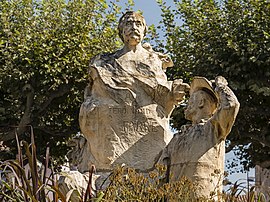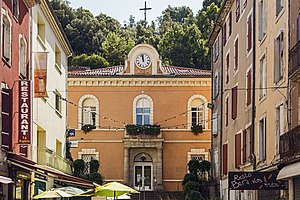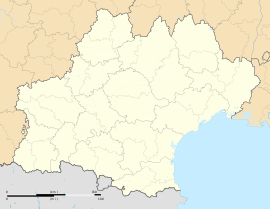Bédarieux
Bédarieux | |
|---|---|
 Statue of Ferdinand Fabre | |
| Coordinates: 43°37′01″N 3°09′35″E / 43.6169°N 3.1597°E | |
| Country | France |
| Region | Occitania |
| Department | Hérault |
| Arrondissement | Béziers |
| Canton | Clermont-l'Hérault |
| Government | |
| • Mayor (2020–2026) | Francis Barsse[1] |
Area 1 | 27.82 km2 (10.74 sq mi) |
| Population (2022)[2] | 5,820 |
| • Density | 210/km2 (540/sq mi) |
| Time zone | UTC+01:00 (CET) |
| • Summer (DST) | UTC+02:00 (CEST) |
| INSEE/Postal code | 34028 /34600 |
| Elevation | 184–520 m (604–1,706 ft) (avg. 196 m or 643 ft) |
| 1 French Land Register data, which excludes lakes, ponds, glaciers > 1 km2 (0.386 sq mi or 247 acres) and river estuaries. | |
Bédarieux (French pronunciation: [bedaʁjø]; Occitan: Bedarius) is a town and commune in the Hérault department in the region of Occitanie in southern France. The town is surrounded by the Espinouse mountain and Orb river, and is in the Haut-Languedoc Regional Nature Park.
The inhabitants are called Bédariciens.
Geography
[edit]Bédarieux is 56 km (35 mi) west of Montpellier and 30 km (19 mi) north of Béziers. The commune is in the Orb valley, the river flowing north–south into Bédarieux and east–west downstream.

Climate
[edit]Bédarieux has a mediterranean climate (Köppen climate classification Csa). The average annual temperature in Bédarieux is 13.6 °C (56.5 °F). The average annual rainfall is 1,008.6 mm (39.71 in) with October as the wettest month. The temperatures are highest on average in July, at around 22.4 °C (72.3 °F), and lowest in January, at around 6.2 °C (43.2 °F). The highest temperature ever recorded in Bédarieux was 40.6 °C (105.1 °F) on 12 August 2003; the coldest temperature ever recorded was −8.7 °C (16.3 °F) on 8 February 2012.
| Climate data for Bédarieux (1981–2010 averages, extremes 1991−present) | |||||||||||||
|---|---|---|---|---|---|---|---|---|---|---|---|---|---|
| Month | Jan | Feb | Mar | Apr | May | Jun | Jul | Aug | Sep | Oct | Nov | Dec | Year |
| Record high °C (°F) | 19.8 (67.6) |
24.4 (75.9) |
25.7 (78.3) |
28.4 (83.1) |
33.6 (92.5) |
39.7 (103.5) |
37.9 (100.2) |
40.6 (105.1) |
34.7 (94.5) |
30.3 (86.5) |
23.9 (75.0) |
19.9 (67.8) |
40.6 (105.1) |
| Mean daily maximum °C (°F) | 9.8 (49.6) |
10.8 (51.4) |
14.3 (57.7) |
16.9 (62.4) |
21.4 (70.5) |
25.9 (78.6) |
28.8 (83.8) |
28.5 (83.3) |
23.3 (73.9) |
18.2 (64.8) |
13.0 (55.4) |
10.1 (50.2) |
18.5 (65.3) |
| Daily mean °C (°F) | 6.2 (43.2) |
6.7 (44.1) |
9.6 (49.3) |
11.9 (53.4) |
15.9 (60.6) |
19.8 (67.6) |
22.4 (72.3) |
22.2 (72.0) |
17.8 (64.0) |
14.1 (57.4) |
9.4 (48.9) |
6.6 (43.9) |
13.6 (56.5) |
| Mean daily minimum °C (°F) | 2.7 (36.9) |
2.6 (36.7) |
4.9 (40.8) |
6.9 (44.4) |
10.3 (50.5) |
13.8 (56.8) |
16.0 (60.8) |
16.0 (60.8) |
12.4 (54.3) |
10.0 (50.0) |
5.7 (42.3) |
3.1 (37.6) |
8.7 (47.7) |
| Record low °C (°F) | −7.8 (18.0) |
−8.7 (16.3) |
−7.8 (18.0) |
−3.3 (26.1) |
0.5 (32.9) |
5.8 (42.4) |
9.0 (48.2) |
6.8 (44.2) |
3.3 (37.9) |
−2.5 (27.5) |
−8.0 (17.6) |
−7.8 (18.0) |
−8.7 (16.3) |
| Average precipitation mm (inches) | 102.3 (4.03) |
73.6 (2.90) |
51.4 (2.02) |
90.5 (3.56) |
83.8 (3.30) |
40.6 (1.60) |
34.6 (1.36) |
45.3 (1.78) |
110.0 (4.33) |
142.2 (5.60) |
109.9 (4.33) |
124.4 (4.90) |
1,008.6 (39.71) |
| Average precipitation days (≥ 1.0 mm) | 8.3 | 6.4 | 6.5 | 8.3 | 7.4 | 4.8 | 3.9 | 5.2 | 6.4 | 8.8 | 7.5 | 8.2 | 81.5 |
| Source: Meteociel[3] | |||||||||||||
History
[edit]
Archaeological digs conducted in the 'rues Basses' district during the 1910s found Roman coins dating from the 4th century AD, suggesting the presence of a Gallo-Roman villa.[4] The earliest mention of the town dates back to the 12th century.[5] The Saint-Nazaire de Lodéran chapel (now disappeared) was mentioned in 1153.
From the end of the 12th century, Bédarieux saw a rapid development of manufacturing activity. Its cloth-weaving industry, carried on under a special royal privilege from the end of the 17th century to the French Revolution, employed in 1789 as many as 5,000 workmen, while some thousand more were employed in wool and cotton spinning, etc. Because of the introduction of modern machinery from England and loss of trade with the Levant, Bédarieux's industries declined. However, they somewhat revived in the late 19th century owing partly to the opening up of Bauxite and coal mines in the neighbourhood.[6]
Bédarieux's first municipal council dates back to 1790. At around the same time the town became the cantonal capital. During the French Revolution, the citizens of the commune of Bédarieux formed a revolutionary club called 'Société des Amis de la Constitution' (the society of the friends of the constitution). It had 250 members.[7]
After Louis-Napoleon's coup d'état on 2 December 1851, Bédarieux's republicans managed to hold the town for a few hours.[8] The press claimed that these insurgents had devoured the corpse of the maréchal des logis, Léotard, who had been fighting for Napoléon III. This claim appears to be untrue, but it seems that they may have urinated on his corpse and burnt his mustaches.
The railway came to Bédarieux in the 1850s. A 710 metre-long viaduct was constructed across the Orb valley, giving rail access to the coal mines at Graissessac. The railway facilitated communications with Béziers, Sète and Marseille, benefiting Bédarieux's wool and leather trade.[9]
During the twentieth century Bédarieux was badly affected by the two world wars and industrial decline. In response, Bédarieux has focused on developing tourism and its cultural industries, as well as seeking to attract new enterprises. Recent improvements include a new sewage treatment plant, several enterprise zones and 'La Tuilerie' - a multipurpose community center that can host conferences, concerts, theatricals and exhibitions.
Population
[edit]
|
| ||||||||||||||||||||||||||||||||||||||||||||||||||||||||||||||||||||||||||||||||||||||||||||||||||||||||||||||||||
| Source: EHESS[10] and INSEE (1968-2017)[11] | |||||||||||||||||||||||||||||||||||||||||||||||||||||||||||||||||||||||||||||||||||||||||||||||||||||||||||||||||||
Twin towns
[edit]Bédarieux is twinned with:
 Leutkirch im Allgäu, Germany, since 1982
Leutkirch im Allgäu, Germany, since 1982 Medenine, Tunisia, since 1999
Medenine, Tunisia, since 1999 Ouarzazate, Morocco, since 2008
Ouarzazate, Morocco, since 2008
Sights
[edit]- Several streets in Bédarieux retain their 17th-century architecture.
- The former castle, La Bastide dates from the fourteenth century. It has machicolations, arrow slits and a 16th-century well. A wooden beam has been dendrochronologically dated to 1350, but evidence exists to suggest this had been part of the machicolations of a lower, squatter tower. The well, too, may date from this first construction by the Abbey of Villemagne, (a nearby village) as part of the defences of the ford crossing the River Orb. A document dated 1156 records the king, Louis VII, granting the Abbot the right to extend the fortifications protecting his properties. This, it is assumed, included the construction of La Bastide. The whole property was sold into private hands in the late 16th century, when it became a domaine owning all the land between itself and Bédarieux, two kilometres away.
- The Promenade de la Perspective (1742), a dyke built to protect the town from the flooding of the river Orb. 200-year-old plane trees grow along its length.
- 16th-century bridge over the Orb
- 19th-century railway viaduct with 37 arches
- Church of Saint-Alexandre built in the 17th–19th century (though recorded in 1189)
- Maison des Arts: a museum occupying a former hospice. It was opened in 1976 and collects together regional heritage: painting, folklore, archaeology, geology, natural history, folk arts and traditions.
Personalities
[edit]
- Paul Rabaut (1718–94): Protestant pastor.
- Guillaume d'Abbes de Cabrebolles (1718–1802), Encyclopédiste was born in Bédarieux.
- Louis-Annibal Escalle (1737–99): Adjudant-Général, one of Napoleon's lieutenants during his campaigns in Italy and Egypt, died at the siege of Acre.
- Ferdinand Fabre (1827–98): writer, novelist, mixing Occitan vocabulary with French in his works (Les Courbezon 1861, Mon oncle Célestin 1881, Toussaint Galabru 1887). He died five days before his election to the Académie Française.[12]
- Pierre Auguste Cot (1837–83): French romantic painter. Le Printemps (Spring) is one of his best-known works.
- Eugène Vaillé (1875–1959): French postal historian and first curator of the French Postal Museum (musée postal de France), later the Museum of the Post Office.
- Guillaume Bouisset (born 7 January 1973), footballer
- Vincent Candela (born 24 October 1973), French footballer who played for many years in Italy, 40 appearances for his national team, including the World Cup in 1998.
See also
[edit]References
[edit]- ^ "Répertoire national des élus: les maires" (in French). data.gouv.fr, Plateforme ouverte des données publiques françaises. 13 September 2022.
- ^ "Populations de référence 2022" (in French). The National Institute of Statistics and Economic Studies. 19 December 2024.
- ^ "Normales et records pour Bedarieux (34)". Meteociel. Retrieved 4 June 2022.
- ^ Bulletin "Archéologie et histoire des Hauts Cantons", vol 24, éd. Document Systems, 2001
- ^ Société archéologique et historique des Hauts Cantons de l'Hérault, Conseil général du Département de l'Hérault [Odyssée; 0182-3876], Bulletin de la société archéologique et historique des Hauts Cantons de l'Hérault
- ^ One or more of the preceding sentences incorporates text from a publication now in the public domain: Chisholm, Hugh, ed. (1911). "Bédarieux". Encyclopædia Britannica. Vol. 3 (11th ed.). Cambridge University Press. p. 613.
- ^ Jean-François Dubost, Le réseau des Sociétés Politiques dans le département de l'Hérault pendant la Révolution Française (1789-1795), in Annales historiques de la Révolution française, no 278, 1989, p. 414
- ^ Éric Anceau, « Le coup d'État du 2 décembre 1851 ou la chronique de deux morts annoncées et l'avènement d'un grand principe », Parlement[s], Revue d'histoire politique 2009/2 (No. 12). ISSN 1768-6520, p. 35.
- ^ Histoire de Bédarieux. Réimpression de l'édition de 1911. Lacour, 1990; ISBN 2-86971-263-4.
- ^ Des villages de Cassini aux communes d'aujourd'hui: Commune data sheet Bédarieux, EHESS (in French).
- ^ Population en historique depuis 1968, INSEE
- ^ Gosse, Edmund William (1911). . Encyclopædia Britannica. Vol. 10 (11th ed.). pp. 117–118.





